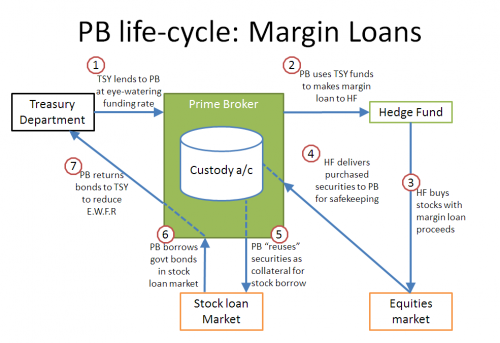Margin lending
|
SFTR Anatomy™
3(10) ‘margin lending transaction’ means a transaction in which a counterparty extends credit in connection with the purchase, sale, carrying or trading of securities, but not including other loans that are secured by collateral in the form of securities; Regulation on Transparency of Securities Financing Transactions and of Reuse (2015/2365/EC (EUR Lex)), aka the securities financing transactions regulation
|
A margin lending transaction is one where one party lends money to another so it can buy or sell securities. The lender will lend up to a certain value of the securities. If the securities fall in value, the lender may ask the borrower to post margin to cover the value of the margin loan.
Usually the borrower lets the lender hold the securities as collateral for the margin loan. The borrower may also allow the lender to use those securities in the market to offset its funding costs of making the margin loan.
This is the classic prime brokerage trade. I’m a hedge fund, and I am all about Vega — the Greek that denotes leverage.[1]
How do I get my spectacular returns? Alpha Leverage, that’s how. I buy securities “on margin”. This means I buy the security, and you, dear prime broker, pay for it. Well, strictly speaking, you lend me the funds I need to pay for it, but in practice you settle the transaction directly with the executing broker and you take delivery of the security on my behalf. For, in return for your loan, I let you look after the security for me, whereby you can (A) have a security interest over it to secure your loan, and (B) you can rehypothecate it into the market to defray the stentorian funding costs your treasury department chrged you to give you the money you needed to providing me with the margin loan in the first place.
I must pay you initial margin as cover should the value of my new asset decline against repayment value of the outstanding margin loan.
The steps, in order, are:
- The PB acquires a credit line from its own treasury department. business being business, and capital charges being capital charges, this is eye-wateringly expensive.
- The PB lends that money to its hedge fund client in a margin loan.
- The HF buys a security with that money.
- The HF settles the security into its custody account with the PB. From the PB’s perspective the deal is this: I pay for (most of) your asset; you settle the asset to me, where I can (i) look after it for you, (ii) hold it as collateral for your Margin loan, and (iii) reuse it to reduce my funding costs.
- The PB accordingly does reuse the asset. It “rehypothecates” it (takes title to it, basically) and uses it as collateral to a stock borrow loan ...
- ...under which it has borrowed high-quality bonds from the market that meet its treasury department’s exacting standards, whereupon it
- Delivers the borrowed bonds to Treasury for them to use in their treasury operations. They are so pleased they give the prime broker a credit on its eye-watering financing rate it charged it under step 1.
Easy.
See also
References
- ↑ “My name is Vega. I live on the second floor. I live upstairs from you. Yes, I think you’ve seen me before.” — Suzanne Luca
